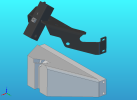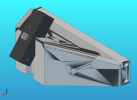Are there any shortcuts or tips when remodeling an STP file? I am doing some 'reverse engineering' and have scanned a part, then converted it to an STP file. I want to remodel the piece in Alibre.
I can go to the STP image, make measurements, and then create a model in Alibre, but this is pretty tedious.
Any tips or suggestions on ways to speed up the process? Some of the parts are relatively complicated castings and it will be a pretty good project to redo them. Maybe I'm spending too much time doing this but I would be much more comfortable having the _PRT file rather than a Modified STP file
Same way with some Solidworks sldprt files or Catia STEP exports. I know the data is accurate, just not 'editable' in Alibre.
Open to any ideas
Thanks
Paul
I can go to the STP image, make measurements, and then create a model in Alibre, but this is pretty tedious.
Any tips or suggestions on ways to speed up the process? Some of the parts are relatively complicated castings and it will be a pretty good project to redo them. Maybe I'm spending too much time doing this but I would be much more comfortable having the _PRT file rather than a Modified STP file
Same way with some Solidworks sldprt files or Catia STEP exports. I know the data is accurate, just not 'editable' in Alibre.
Open to any ideas
Thanks
Paul


